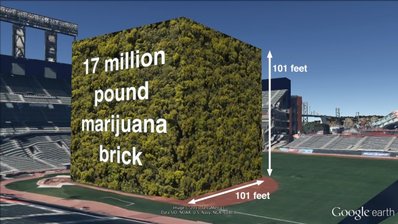
After weeks of poring over 128,000 drug seizure records released to The Center for Investigative Reporting by U.S. Customs and Border Protection, there were lots of facets to run down on four types of drugs, but it was clear there was one point we had to emphasize: 17 million pounds. That's a lot of marijuana, dude.
This video is our attempt (with much respect to the venerable "All Your Base Are Belong to Us" meme) to help members of the public wrap their heads around that massive number. And who doesn't love a 101-foot-tall brick of solid swag? Or a 583-foot-tall 3-D flying joint?
But because you're all nerds, here's the math behind the laser fight.
Where did 17 million pounds come from?
CIR analyzed 128,169 seizure incidents near the U.S.-Mexico border between January 2005 and early October 2011. The data includes drugs seized by the U.S. Border Patrol and at ports of entry by Customs and Border Protection. The data does not include seizures by other federal or local law enforcement agencies.
Total marijuana seized: 7,705,746 kilograms (16,988,262 pounds)
Giant brick

According to Tommy LaNier, director of the National Marijuana Initiative for the White House's Office of National Drug Control Policy, the size varies, but an average brick of compressed marijuana weighs 1 kilogram and has dimensions of 8.5 inches by 11 inches by 2.5 inches.
That makes the volume of a 1-kilogram 233.75 cubic inches (8.5 * 11 * 2.5).
So, a 7,705,746-kilogram brick would have a volume of 1,801,218,128 cubic inches (7,705,746 * 233.75) or 1,042,371.6 cubic feet.
Now we need the final dimensions. For simplicity's sake, we'll make our giant brick a cube. So to find the dimensions, we find the cube root of the total volume, or 101 feet:
As you can see in the video, such a brick would more than fill the infield of the San Francisco Giants' AT&T Park and cover much of the Sydney Opera House's portico.
16.3 billion joints
According to LaNier, federal agencies generally assume that an ounce of the lower-quality marijuana smuggled from Mexico yields about 60 joints. (High-quality weed can yield around 120 joints per ounce.)
Sixty joints per ounce = 960 joints per pound or 2,112 joints per kilogram
7,705,746 kilograms of marijuana * 2,112 joints per kilogram = 16,274,535,552 joints
Giant joint

To get our giant joint, we'll need to know the volume of a standard-size joint. Again, the sizes vary considerably, but give us a break: It's a funny video. For our calculations, we assumed the joint was made using a classic Zig-Zag 70-millimeter rolling paper.
Single joint dimensions (rolled): 7 centimeters long with a radius of 0.477 centimeters (circumference of 3 centimeters)
Volume of single joint: 5 cubic centimeters
Volume of giant joint: 16,274,535,552 joints * 5 cubic centimeters = 81,372,677,760 cubic centimeters
We want our giant joint to have nearly the same proportions as our standard joint, so we want a radius-to-length ratio of 0.477 / 7, or 0.068. So we solve for:
(This is too hard for us to remember how to do from high school algebra, so thanks to Truman State University math professor Jason Shaw for helping us out with this one.)
We end up with a joint 17,759.755 centimeters long with a radius of 1,207.663 centimeters (583 feet long with a 40-foot radius).
That's much taller than the Statue of Liberty (305 feet from the ground to the flame), and taller than the Washington Monument (555 feet). Possibly related: As it turns out, the Eiffel Tower is really, really tall. Look it up.
You might also be wondering why the giant joint is so much bigger than the giant brick. Remember, brick marijuana is highly compressed and is smoked once it has been pulled apart.
Border fence of joints

The U.S.-Mexico border is 1,969 miles long (3,169 kilometers), according to the International Boundary and Water Commission. So if you laid standard 7-centimeter joints end to end, it would take 45,271,429 joints to span the whole border. No problem – we've got billions! So you could span the border 359 times. Stacking 359 joints with a diameter of 0.954 centimeters yields a 3.42-meter-tall (11.2-foot-tall) fence. This is much bigger than the actual current border fence, which is about 700 miles long.
Total border: 3,169 kilometers (316,900,000 centimeters)
1 border = 45,271,429 joints
16,274,535,552 joints / 45,271,429 joints per border = 359 joints high = 3.42 meters
Giant brick/Giant joint space fight

That wasn't real. Many governments have tried to make energy weapons practical over the years, but laser cannons remain science fiction.
Investigative reporting is an essential pillar of a democratic society. For more than three decades, the Center for Investigative Reporting (CIR) has relentlessly pursued and revealed injustices that otherwise would remain hidden from the public. Its reports have sparked state and federal hearings and legislation, public-interest lawsuits and changes in corporate policies. For more information, please visit cironline.org.